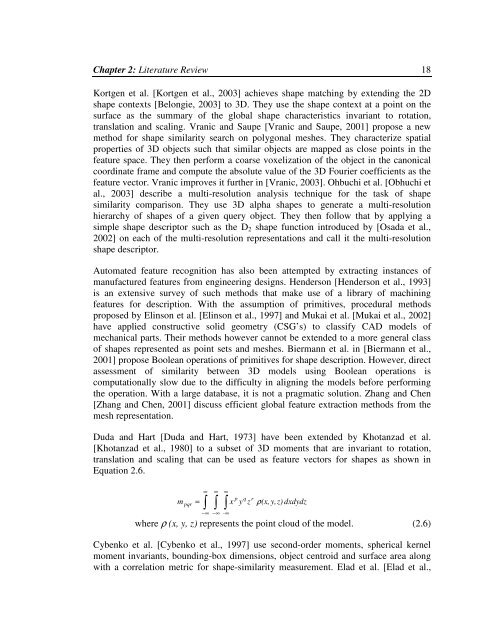To the Graduate Council: I am submitting herewith a thesis written by ...
To the Graduate Council: I am submitting herewith a thesis written by ...
To the Graduate Council: I am submitting herewith a thesis written by ...
You also want an ePaper? Increase the reach of your titles
YUMPU automatically turns print PDFs into web optimized ePapers that Google loves.
Chapter 2: Literature Review 18Kortgen et al. [Kortgen et al., 2003] achieves shape matching <strong>by</strong> extending <strong>the</strong> 2Dshape contexts [Belongie, 2003] to 3D. They use <strong>the</strong> shape context at a point on <strong>the</strong>surface as <strong>the</strong> summary of <strong>the</strong> global shape characteristics invariant to rotation,translation and scaling. Vranic and Saupe [Vranic and Saupe, 2001] propose a newmethod for shape similarity search on polygonal meshes. They characterize spatialproperties of 3D objects such that similar objects are mapped as close points in <strong>the</strong>feature space. They <strong>the</strong>n perform a coarse voxelization of <strong>the</strong> object in <strong>the</strong> canonicalcoordinate fr<strong>am</strong>e and compute <strong>the</strong> absolute value of <strong>the</strong> 3D Fourier coefficients as <strong>the</strong>feature vector. Vranic improves it fur<strong>the</strong>r in [Vranic, 2003]. Ohbuchi et al. [Obhuchi etal., 2003] describe a multi-resolution analysis technique for <strong>the</strong> task of shapesimilarity comparison. They use 3D alpha shapes to generate a multi-resolutionhierarchy of shapes of a given query object. They <strong>the</strong>n follow that <strong>by</strong> applying asimple shape descriptor such as <strong>the</strong> D 2 shape function introduced <strong>by</strong> [Osada et al.,2002] on each of <strong>the</strong> multi-resolution representations and call it <strong>the</strong> multi-resolutionshape descriptor.Automated feature recognition has also been attempted <strong>by</strong> extracting instances ofmanufactured features from engineering designs. Henderson [Henderson et al., 1993]is an extensive survey of such methods that make use of a library of machiningfeatures for description. With <strong>the</strong> assumption of primitives, procedural methodsproposed <strong>by</strong> Elinson et al. [Elinson et al., 1997] and Mukai et al. [Mukai et al., 2002]have applied constructive solid geometry (CSG’s) to classify CAD models ofmechanical parts. Their methods however cannot be extended to a more general classof shapes represented as point sets and meshes. Biermann et al. in [Biermann et al.,2001] propose Boolean operations of primitives for shape description. However, directassessment of similarity between 3D models using Boolean operations iscomputationally slow due to <strong>the</strong> difficulty in aligning <strong>the</strong> models before performing<strong>the</strong> operation. With a large database, it is not a pragmatic solution. Zhang and Chen[Zhang and Chen, 2001] discuss efficient global feature extraction methods from <strong>the</strong>mesh representation.Duda and Hart [Duda and Hart, 1973] have been extended <strong>by</strong> Khotanzad et al.[Khotanzad et al., 1980] to a subset of 3D moments that are invariant to rotation,translation and scaling that can be used as feature vectors for shapes as shown inEquation 2.6.∞∞∞ m = x y z ρ (x, y,z) dxdydzpqr−∞ −∞ -∞pqrwhere ρ (x, y, z) represents <strong>the</strong> point cloud of <strong>the</strong> model. (2.6)Cybenko et al. [Cybenko et al., 1997] use second-order moments, spherical kernelmoment invariants, bounding-box dimensions, object centroid and surface area alongwith a correlation metric for shape-similarity measurement. Elad et al. [Elad et al.,
















